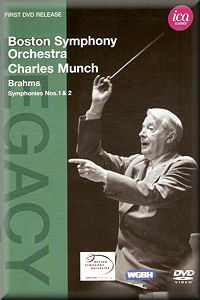 |
 |
|


alternatively
MDT
AmazonUK
AmazonUS
|
Johannes BRAHMS (1833-1897)
Symphony No. 1 in C minor Op.68
Symphony No. 2 in D major Op.73
 Boston Symphony Orchestra/Charles Munch
Boston Symphony Orchestra/Charles Munch
rec. live, Sanders Theatre, Harvard University, October 1961 (No.1) and April 1960 (No.2)
Menus E, Picture Format 4;3, Region Code 0, DVD Format NTSC; Sound Ambient mastering, Black and white
 ICA CLASSICS ICAD 5029
ICA CLASSICS ICAD 5029  [89:44]
[89:44]
|
|
|
The existence of so many Munch DVDs is proving to be exceptionally
valuable, the visual corollary to all the many reissues now
being produced devoted to his still-striking Boston legacy.
One other attendant feature of the filmed concerts is the approach
of those responsible for them, WGBH TV. The station seems to
have taken a peculiarly quixotic approach to presenting the
conductor – or not, as the case may be.
We follow him as he makes his exceptionally brisk and athletic
way to the rostrum at Sanders Theatre, Harvard University (not
Symphony Hall). Thenceforth things are more reliant on interpretative
gestures from the camera director. We see section principals
and panning shots down the sections; we concentrate on those
with solos, sometimes jerkily and just missing the optimum moment
or occasionally, as with the finale of the Second Symphony,
concentrating for the final paragraph exclusively on the orchestra.
The effect is exciting, but it seems perverse to exclude the
conductor wholly; yes, the percussion and brass are the engines
of the writing, but by excluding Munch’s cues we miss just how
he generated the dynamism and control that he so often exercised.
In the slow movement of the First there’s a split-screen effect
where the concertmaster and horn principal are each given an
oval ‘photographic’ surround as they play. This accords the
whole thing a ‘moving picture’ effect. It’s rather charming,
if a bit simplistic.
When we concentrate on Munch, conducting without a score on
both occasions – the concerts were given in April 1960 and October
1961 and are in black and white – we find those occasional Furtwängler-like
flails, moments, too, of jumping, and the arcing sweep of the
baton. Because of a peculiarity of the film, in the First Symphony
at several points his baton seems to split into two, rather
like a Druidic wand, so that it seems to vest him with arcane,
almost spectral powers. Talking of the film quality, it must
be admitted that it’s variable. The First Symphony is more consistent,
but the Second lacks a degree of definition and there’s bleaching
of the image at a number of points. In the First there’s screen
flicker at the top of the image for a little while in the finale,
and annoying ‘white spot’ degradation earlier on. One should
stress that these are not so awful that watching becomes at
all onerous – but they should be noted.
These are worthwhile acquisitions, despite their limitations
in sound and picture quality. Munch’s performance of the Second
I find preferable to the First, but seeing him in action – well,
most of the time – is an invigorating and valuable experience.
Jonathan Woolf
|
|

